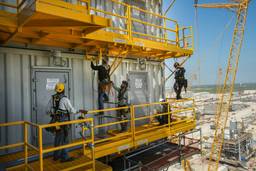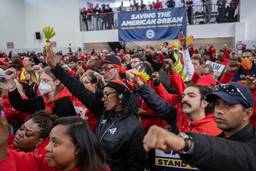Can UPS and the Teamsters Reach a Deal?
Teamsters General President Sean M. O’Brien tweeted Saturday that “huge gains have been made” but “we’re not across that goal line yet.”
Stephen Franklin
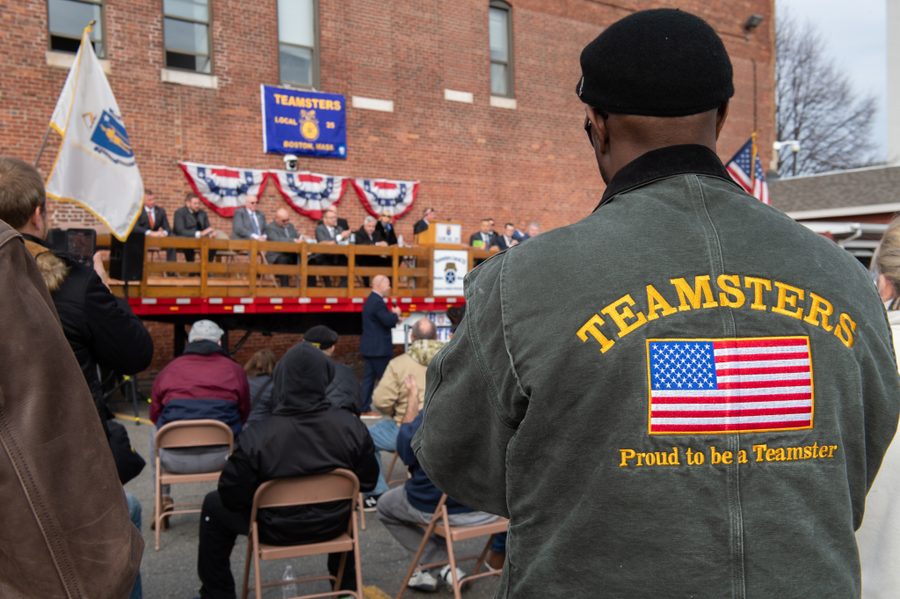
When the temperature hits three digits in the brown UPS truck Luis Rivera drives, he slows down his deliveries, which gets him in trouble, he says, with his boss.
“They say, ‘Why did you take so long?’ and I say, ‘Dude, it’s hot. I know when I need to take a break,” explains Rivera, a veteran delivery driver and Teamsters member in Central California, where heat waves are common.
Rivera ticks off the times that colleagues have gotten heatstroke and recalls the tragedy of a young UPS driver, 23-year-old Jose Cruz Rodriguez Jr., who died two years ago in Waco, Texas. His family alleges that the death was heat related and the Occupational Safety and Health Administration fined UPS $14,502 for that incident. The company is appealing.
Amid complaints from workers like Rivera, the Teamsters have repeatedly told the delivery giant that it must air condition its delivery vehicles, especially in climates where the heat can soar. But the company repeatedly pushed back.
“We always said we didn’t think that air conditioning was the solution for a variety of reasons,” says a UPS official, who spoke on condition of anonymity.
So when UPS agreed in contract talks in mid-June to begin air conditioning its delivery fleet, some considered it a sign that the union’s 340,000 UPS members and the world’s largest small package delivery service could find common ground, and that contract talks would not collapse into a costly — and potentially economically devastating — strike come the July 31 deadline.
But the mood has become more complicated as they dance through a series of feints and parries.
The Teamsters walked out of contract talks on Thursday, June 22, and vowed not to return to the bargaining table until the company makes a “realistic and respectful economic offer.” Leaked details of a UPS counter proposal — that were authenticated and posted by The Upsurge (a podcast co-sponsored by In These Times and The Real News Network) — indicate limited wage increases for part-timers and a lower starting tier of wages for new employees.
“Our committee & more importantly our members don’t have the patience for bullsh*t proposals like the one @UPS gave today. If this company wants to negotiate a contract for 1997 working conditions, they’re going to get 1997 consequences. #GetFckingReal” tweeted Teamsters General President Sean M. O’Brien.
When the union returned several days later, they said the company had not come up with a new package and they gave UPS a week to come up with a tentative agreement or a final offer.
Then, on June 28, O’Brien tweeted that “Despite the ‘play nice’ public persona, @UPS has ignored our demands at the table. They want to keep screwing our members while making billions off their backs. Not f*cking happening. We’re putting an end to the disrespect. You have 48 hours to provide the last, best, final offer.”
Come Friday, June 30, however, the union said UPS had made an offer with “significant” improvements on wage and economic issues and had agreed to reach a deal by July 5. (A UPS source, speaking on condition of anonymity, would not confirm whether or not they would stick to the July 5 deadline.)
“UPS came back with real movement, but it isn’t enough. After they left the room, our national committee had a long dialogue and the universal consensus was to continue our leverage campaign,” Teamsters General Secretary-Treasurer Fred Zuckerman said in a news release on June 30. “One of two things is going to happen next — UPS will come to terms on a deal we can confidently recommend to our members or UPS will fail and the company will put itself on the street.”
Zuckerman also noted that “thousands of UPS Teamsters are practice picketing right now across the country, showing UPS how serious we are about getting the best contract in our history.”
In similar fashion to its other upbeat replies to Teamsters negotiations’ actions, the company simply said in a news release that it was “encouraged the Teamsters are ready to continue negotiations and discuss our most recent proposal.”
Then, after movement at the negotiating table on Saturday, July 1, O’Brien tweeted that “Huge gains have been made today & proud of our team. But to be clear, we’re not across that goal line yet. #MoreWorkToDo”
In a video update about the negotiations posted on July 1, O’Brien talked about the importance of the July 5 deadline, saying that it was necessary to reach a deal by then so that Teamsters members across the country could have time to review the proposal, talk about it with their locals, and vote on the process.
Contract talks are always a drama built around facts and personalities, but this one is hyped more than most. It is almost a showdown of sorts for O’Brien and UPS. O’Brien has raised the stakes for a new five-year contract for his UPS members to a higher level, saying recently at meetings and a union webinar it can set “the tone for the entire labor movement across this country.”
“There is no better organization to set that bar high than the International Brotherhood of Teamsters,” he told a union meeting in April in Boston.
He might be right.
Overall, the negotiations between the union (with 1.2 million members) and UPS touch on hot button issues for the nation’s long-suffering unions and millions of workers.
Union officials say they basically want to sweep aside two-tier wages, turn more part-time jobs into full-time work, and let workers reap some of the hefty revenue UPS gained during the pandemic and afterwards. The company’s total revenues increased 35% between 2019 and 2022, and the union likes to advertise that the UPS CEO, Carol B. Tomé, is paid more in a day “than a UPS worker is paid in an entire year.” Her total compensation in 2022 was $18.9 million.
Amid the union’s bluster, UPS’s low-key mantra is that it is not angling for a fight, but just wants to be able to compete amid fierce competition.
“There’s only been one national strike and that’s a strong indication that we will work together for a resolution. We fully expect to realize an agreement before the end of our contract,” says Glenn Zaccara, a UPS spokesman.
And then there’s O’Brien’s need to certify the gutsy leadership style that he promised in his campaign to lead the union.
A fourth generation Teamster from Boston, the 51-year-old O’Brien is a muscular former high school football player who often gleefully tosses rhetorical bombs at UPS, bringing cheering supporters to their feet. If UPS balks at a good contract, he recently told union members in a webinar that “we are going to put their asses on the street.”
A one-time high-ranking ally of former Teamsters General President James P. Hoffa, O’Brien reached out for support from the union’s long-time rival faction, Teamsters for a Democratic Union (TDU), vowing hard-nosed bargaining and more of a voice for the union’s rank-and-file, in his bid to lead the union. O’Brien’s TDU-supported slate handily whipped a Hoffa-aligned team in 2021, though only 15% of the union’s 1.2 million members voted.
O’Brien initially was upbeat about the talks with UPS, bragging in the webinar that in the early round of contract talks, the union had won agreements on 55 workplace issues. And the biggest victory, he boasted, was UPS’ retreat on air conditioning in the delivery vehicles and their agreement to take other steps to fight the heat.
The question is now whether he and the union will reach a compromise with a company that, as UPS officials privately explain, is focused on cutting costs and preserving the flexibility that it needs to compete with lower wage, non-union competitors like FedEx.
“He (O’Brien) shows up and keeps swinging out and they try to respond,” says Brandy Harris, a part-time UPS worker from Seattle who serves on the negotiating committee. It’s the first-time rank-and-file workers have joined in high level contract talks, a change that took place at the union’s 2021 convention, stirred by anger over the union’s previous deal with UPS in 2018.
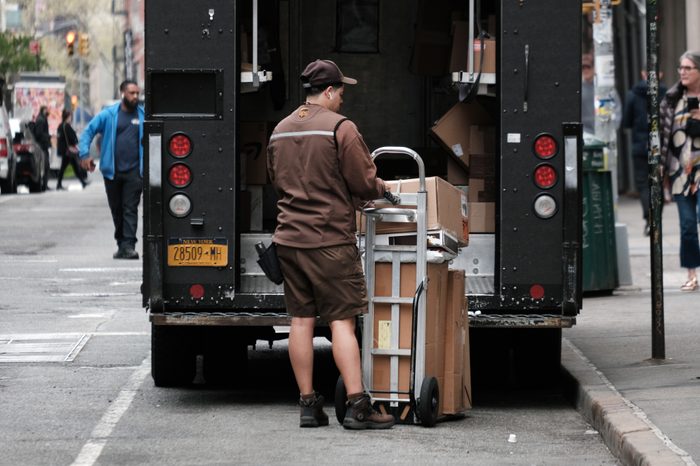
In a campaign to get the Teamsters steamed up about the upcoming five-year contract negotiations with UPS, O’Brien traveled the nation to pump up support and the vote for a strike passed with 97% support. Richard Hooker, the head of Local 623 in Philadelphia, who did not vote for O’Brien, says, for example, that his roughly 5,000-member local broils with anger towards the company because of recent layoffs and their failure to deal with grievances from members with his local.
“They (UPS) are brutal right now because the members are standing up and fighting back,” he says.
Experts say the challenge for Tomé, UPS’s CEO since 2020, is keeping labor costs down while getting the union to let it continue with measures that will allow it to compete against other firms who have eaten into the UPS package delivery market.
UPS’ share of the parcel delivery volume in the United States has dropped from just under 40% in 2014 to 24% in 2021, according to research compiled by Radish Research on behalf of the TDU. The same research shows that labor costs for UPS account for 55% of its total operating expenses as compared to 36% for FedEx.
To match competitors’ weekend deliveries, the union and company agreed in the last contract in 2018 to create a Tuesday through Saturday job that pays about 13% less than for other full-time workers. That didn’t go over well with the union’s members, who voted the contract down.
UPS officials say that deal wasn’t enough to meet the weekend demand, however, and so the company has required a sixth day or Saturday for some drivers. The union opposes forcing members to work six days.
Part-timers make up more than half of the union’s members at UPS, according to the union. But UPS officials say the figure is closer to 30%. The union wants more of them moved to full-time jobs, and to boost their wage from the current starting level of $15.50 an hour.
Meanwhile, in 2017, UPS stepped up its hiring of a new class of workers, called Personal Vehicle Drivers, to deal with peak season demand. That has angered local union officials who say they are taking away their members’ work. UPS would not say how many of these workers it hires annually.
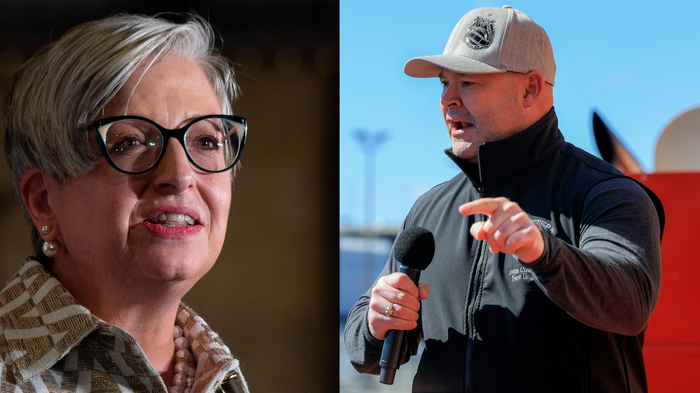
UPS has projected itself a friend of the union and especially as a benefactor for its workers. But it needs a deal from the union because as one UPS official explains, “This is not 1997. The industry has been disrupted in many ways.”
Full-time workers earn an average $95,000 yearly and some earn up to $200,000, UPS officials say. Workers receive another $50,000 worth of benefits including free health care premiums. About 72,000 union jobs have been added since the last contract, and UPS officials say they have not fought to keep union jobs out of its ranks as other high profile corporate giants have.
And now the company’s contract goals, adds the UPS official who asked to remain anonymous, is to “tweak” the current contract.
The union’s strike in 1997 had a devastating impact on UPS’ finances. It suffered a 98% decline in operating profits for that year’s third financial quarter, according to the TDU sponsored research.
Finances may be on UPS’ mind again. In a recent SEC
filling, the company said that the trend around their small package deliveries, which slowed in the first quarter of the year, are expected to continue for 2023 and it has seen a decline from its largest customer, identified by UPS officials as Amazon.
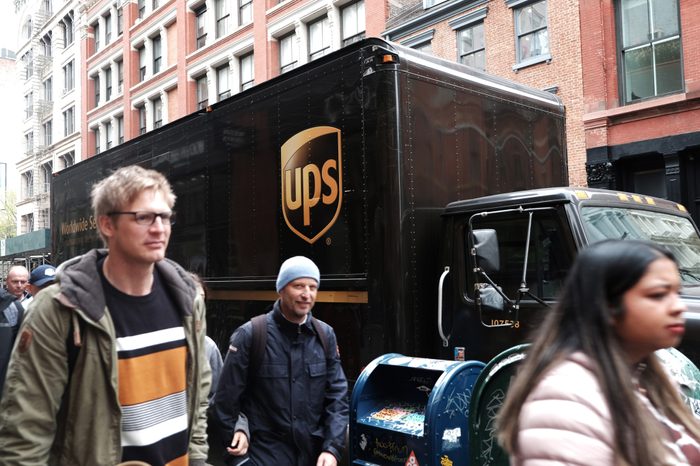
The loss in finances and customers that UPS encountered from the 1997 strike will weigh heavily on the company’s bargaining, says Alan Amling, a former high-ranking UPS official who is now a fellow at the University of Tennessee, Knoxville. “I think it (an agreement) will come right down to the wire,” he says. “We found at UPS in 1997 that there was business that never came back,” he adds, pointing out that the competition for UPS nowadays is “worse.”
Similarly, Satish Jindel, whose firm SJ Consulting advises companies in the transportation and logistics industries, sees only losses for the union and UPS if they tumble into a strike. UPS will lose business and the union will lose jobs. “The only ones who will benefit are FedEx and the US Postal Service. … Whatever they (Teamsters) want from the company, they can be as tough as they want, but they should do it now,” he says.
Replying to the union’s earlier demand for a tentative agreement, UPS previously issued this statement.
“We welcome the Teamsters’ urgency to get a ratified contract in place by August 1. These negotiations affect our people, consumers and businesses across the country, which is a responsibility we take seriously. We’ve been negotiating in good faith to reach an agreement with the Teamsters, and the progress we have made to date reflects our shared commitment to this process. We are prepared to work around the clock until we have a new contract that includes wins for our employees, the Teamsters, our company and our customers.”
As for the complaints from UPS workers like Rivera, who says he gets into trouble with his boss when he slows down on hot days, a UPS spokesman replies that UPS “always want our employees to be safe and we support their needs for rest and hydration on hot days.”
But back in Visalia, Ca. where heat is expected to reach above 100 in early July, Rivera considers the company’s bowing to the union’s demand for air conditioning as a good, but small step. Still, he doesn’t feel well about the company’s use of private drivers and thinks part-timers should earn more.
Mindful of protecting himself on the job, he lugs an extra jug of cool water on hot days, wears a neck gaiter, and urges new, younger workers not to worry about falling behind on their delivery time.
He tells them, “Guys, we need to go slow and take our breaks.”
A former labor writer for the Chicago Tribune, Stephen Franklin is a Pulitzer Prize finalist and an adjunct professor at the University of Illinois Urbana-Champaign School of Labor and Employment Relations.

